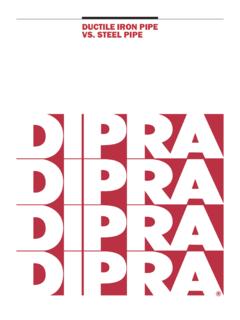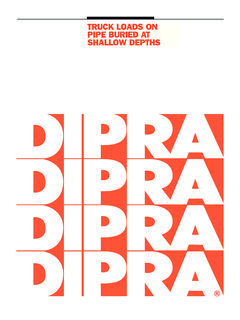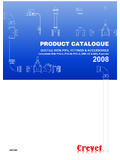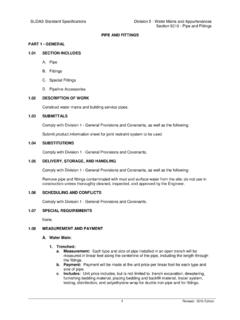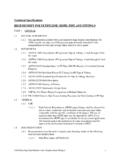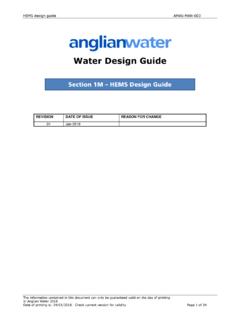Transcription of Bridge Crossings with Ductile Iron Pipe - صفحه اصلی
1 Bridge CROSSINGSWITH Ductile iron pipe 1 Bridge CROSSINGSWITH Ductile iron PIPEI ntroductionThe Ductile iron pipe ResearchAssociation (DIPRA) periodically receivesrequests from engineers and contractorsconcerning recommendations on the designand/or installation of pipelines spanningwaterways, highways, and the variables involved in suchinstallations present numerous alternativesand challenges for designers andcontractors, DIPRA does not providerecommendations and does not assumeresponsibility for design or installationpractices on such projects. DIPRA does,however, recognize the engineeringcomplexities inherent to Bridge crossingpipelines and offers information to assistthose involved with this type of installationand to point out typical design criteria whichshould be considered for Bridge of the entire pipeline as a unitapplied to a Bridge structure involves closedetail to many parameters in bothstructures.
2 The following sections coverthese parameters in iron pipe is centrifugally cast in18- and 20-foot nominal laying diameters range from 3 to 64inches, with a variety of pressure andspecial thickness classes. Although DuctileIron pipe is usually furnished with acement-mortar lining, optional internallinings also are available for a wide range ofspecial applications. Also, Ductile iron pipeis normally furnished with an externalasphaltic shop coat for a finished appearance, although shop-applied primersfor special painting systems also iron pipe is furnished withseveral different types of joints: push-on,mechanical, restrained, ball and socket,flanged, and grooved and shouldered , Bridge Crossings involve push-onjoints, restrained joints, or joints (see Figure 1) areexcellent for bridges with properly designedand constructed supports.
3 Ampledeflections in these joints are possible whenproper lateral and vertical supports areprovided to resist the weight of the pipe andits contents as well as thrust , expansion and contraction of thepipe due to temperature changes can beadequately provided for with such joints; ifmore adjustment is needed, expansioncouplings (see section on Expansion/Con traction Couplings) should joints (see Figure 2) areoften used for fittings but are not generallyused for straight runs of pipe . Toaccommodate possible pipe movementcaused by thermal expansion andcontraction, the push-on joint may be abetter choice than the mechanical joint dueto its deeper socket standard push-on and mechanicaljoints are not restrained, due con -sideration should be given to proper designand construction of supports or anchoragesto resist thrust forces, dead loads, impactand shock loads, and thermal restrained joint complements thepush-on and mechanical types bymaintaining flexibility and also by providingboth ease of assembly and a lockingfeature to resist pull-out.
4 Numerous typesare available employing modifications of thepush-on and mechanical joint designs. In a pressurized system, some flexiblerestrained joints are subject to significantjoint extension. Therefore, when utilizingrestrained joints, proper design andconstruction techniques normally shouldinclude provisions for extending each jointso as to engage its restraints. This may beaccomplished by extending the joints fullyduring assembly and/or by hydrostaticallytesting the horizontal portion of thecrossing separately (using restrainedclosures) before making connections tooffset bends or riser pipes. Cumulative jointextension due to thrust pressure over along crossing could result in over-deflection,excessive movements, and excessive beamloadings to fitting connections at the ends ofa Supports/HangersTypical installations of Ductile iron pipeon bridges involve a pipe on supports approach, depending upon the placementof the pipe on the Bridge and the details ofthe Bridge support system.
5 Referring tothe DIPRA publication, Design of DuctileIron pipe on Supports, the minimumpressure class in all sizes is more thanadequate to support the weight of the pipeand water it contains with one supportper length of pipe ( , a span length of 18or 20 feet).*It is recommended that the saddle angleof the support be between 90 and 120degrees. Little or no benefit is gained byincreasing the saddle angle more than 120degrees, while stresses tend to increaserapidly with angles less than 90 degrees. Itis also recommended to use one supportper length of pipe positioned immediatelybehind the bell. with these assumptions,each span can be conservatively treated as asimply supported is of utmost importance that sufficientvertical and lateral stability be provided atsupports for both restrained andunrestrained joint pipe .
6 When a flexiblyjoined Ductile iron pipeline is pressurized,some thrust forces develop even atslightly deflected joints. If not adequatelystabilized, these forces can cause the jointsto deflect to their maximum, creating a*Note: Proprietary assemblies are available for long span(multiple lengths per support) applications. Contact DIPRA member companies for 1 Figure 2 PUSH-ON JOINTSF astite JointTyton Joint 2 snaking of the pipeline and possibly evenseparation of unrestrained must be designed to carry theweight of the pipe and its contents, and otherapplicable loadings and conditions, such asthrust forces, seismic loadings, trafficvibrations, and insulation in cold location of the pipeline on the bridgewill, in many cases, dictate the type ofsupport to be used.
7 Because of the manytypes of bridges and placements for thesepipelines, specific design details for hangersand/or supports for all possibilities cannotbe presented; however, three commonlocations for pipe placement are inside aconcrete box utility corridor, underneath thedeck between girders, and on the exteriorside. Each location may require differenttypes of support; here is a look at each. Inside a concrete box utilitycorridorSupport of the pipeline inside a box utilitycorridor is normally provided by the ceilingor the floor. A universal hanging detail fromthe ceiling is shown in Diagram movement is restricted bybracing against the side of the box rod lengths are not advisable due tothe possibility of twisting or buckling andthe lack of proper support resulting fromcritical the pipe from the floor ofthe box corridor may be accomplished inseveral ways.
8 One way is shown in DiagramB. Straps should be used to secure the pipeto the support, with each length of pipe strapped down immediately behind thebell (the bell should not rest on the floor). Underneath the deck betweengirdersBecause of the unlimited configurationsin types of bridges and structural supports,it is impossible to address all thevariations. In many cases, the pipe can besupported from the concrete deck as inDiagram A, with sufficient vertical andlateral support from the Bridge under-structure. Where structural steel beamsare used throughout the Bridge , beamclamps present an easy solution to hangingthe pipe ; however, the pipe will alsorequire adequate vertical and lateralsupport.
9 Many bridges have steel beamsrunning laterally under the Bridge whichmay serve to support hangers or cradles. On the exterior sideThe structural material of the bridgeexterior and its design configuration willgenerally dictate the arrangement forinstalling the Ductile iron pipe . Examples ofbridges with concrete or steel exteriors areshown in Diagram C. For bridges withwooden exteriors (see Figure 3), drillingand tapping the supports are done easily inthe field and generally, the spacing ofsupports will accommodate the 18- to 20-foot lengths of Ductile iron pipe . Thespecific design of the supports is unlimitedand open to the discretion of the design choices for any placementlocation are many; however, these specificpoints need to be observed: At least one support per length of pipe is required (unless long span pipe is utilized).
10 The minimum pressure class of Ductile iron pipe is sufficient in all sizes to support the weight of the pipe and its contents. Proper lateral and vertical support is needed to prevent snaking. Expansion/ContractionCouplingsConditions of fluid flow inside a DuctileIron pipeline as well as ambienttemperature changes throughout the year will affect expansion and contraction of thepipeline with respect to the Bridge . Attentionshould be drawn to the fact that bridgeexpansion could differ from that of the pipebecause of (1) differences between bridgeand pipe temperature, with pipe temperaturebeing affected by the temperature of itscontents, (2) differences in coefficients ofthermal expansion,* and (3) locations ofbridge expansion joints which mayconcentrate movement relative to the , the engineer needs to consider theinteraction of expansion/contractioncouplings with thrust restraint systems,especially when restrained joints are used.

